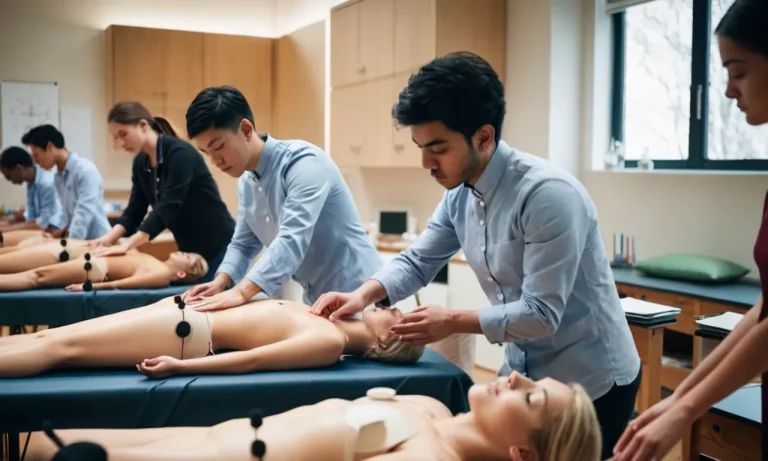Pursuing a career in medicine is a dream for many, but the path to becoming a doctor can be long and arduous. One of the most significant hurdles is the cost of medical education, which can be prohibitively expensive for many students.
This is where community colleges come into play, offering an affordable alternative for students to complete their prerequisite courses before transferring to a four-year university or medical school.
If you’re short on time, here’s a quick answer to your question: Yes, many medical schools do accept community college credits, but there are specific requirements and limitations that vary from institution to institution.
In this comprehensive article, we’ll explore the intricacies of transferring community college credits to medical schools. We’ll delve into the policies and guidelines set by various medical schools, the types of courses that are typically accepted, and the strategies you can employ to maximize your chances of a successful transfer.
Additionally, we’ll address common concerns and misconceptions surrounding this topic, ensuring you have a well-rounded understanding of the process.
Medical School Admission Requirements
Getting into medical school is no easy feat – it requires a combination of academic excellence, extracurricular involvement, and a genuine passion for the field of medicine. One of the most crucial aspects of the admission process is meeting the prerequisite course requirements.
These prerequisites vary from school to school, but typically include courses in biology, chemistry, physics, and mathematics.
Prerequisites and Course Requirements
Before applying to medical school, prospective students must complete a series of undergraduate courses that lay the foundation for their future medical education. These courses are designed to ensure that students have a solid understanding of the fundamental scientific principles that underlie the study of medicine.
While the specific requirements may vary, most medical schools require the following courses:
- One year of general biology with lab
- One year of general chemistry with lab
- One year of organic chemistry with lab
- One year of physics with lab
- One year of English composition and literature
- Courses in mathematics, such as calculus or statistics
Accreditation and Course Equivalency
When it comes to fulfilling these prerequisite requirements, one question that often arises is whether medical schools accept community college credits. The short answer is yes, many medical schools do accept community college credits, provided that the courses are equivalent to those offered at four-year institutions and are taken at an accredited community college. However, it’s essential to check with each medical school’s specific policies, as some may have restrictions or limitations on the number of community college credits they accept.
To ensure that your community college credits are transferable, it’s crucial to confirm that the courses you take are equivalent to those required by the medical schools you’re interested in. Many community colleges have established course equivalency agreements with nearby four-year institutions, which can simplify the transfer process.
Additionally, the American Medical College Application Service (AMCAS) provides a course equivalency guide that can help you determine if your community college courses meet the requirements.
GPA and MCAT Scores
While meeting the prerequisite course requirements is essential, it’s not the only factor that medical schools consider during the admission process. Your overall grade point average (GPA) and performance on the Medical College Admission Test (MCAT) are also critical components of your application. According to data from the Association of American Medical Colleges (AAMC), the average GPA for students accepted to medical school in 2021 was 3.73, and the average MCAT score was 511.9 out of 528.
😮 However, these numbers are simply averages, and many successful applicants fall outside of these ranges.
It’s worth noting that medical schools take a holistic approach when evaluating applicants, considering factors such as extracurricular activities, research experience, community service, and personal statements.
While a strong academic record is crucial, it’s also essential to demonstrate well-roundedness, leadership qualities, and a genuine commitment to the field of medicine. 👏
Transferring Community College Credits
Many aspiring medical students begin their academic journey at community colleges to save on tuition costs and complete prerequisite courses. The good news is that most medical schools accept transfer credits from accredited community colleges, but the policies and guidelines can vary.
Let’s dive into the details!
Policies and Guidelines
Medical schools typically have specific policies in place for accepting transfer credits from community colleges. These policies outline the criteria for course eligibility, minimum grade requirements, and the maximum number of transferable credits.
According to the Association of American Medical Colleges (AAMC), the majority of medical schools accept up to 60 semester credits or 90 quarter credits from community colleges or other four-year institutions.
Maximum Transferable Credits
The maximum number of transferable credits can vary among medical schools, but most institutions cap it at around 60-90 credits. For instance, The University of North Carolina School of Medicine allows up to 60 semester hours of transfer credit, while Boston University School of Medicine accepts a maximum of 90 quarter hours.
It’s crucial to check with your target medical schools to understand their specific transfer credit policies and limits.
Course Evaluation Process
Medical schools have a rigorous course evaluation process to ensure that the transferred credits meet their academic standards. Here’s a general overview of how it works:
- Applicants submit official transcripts from all previously attended institutions, including community colleges.
- The admissions committee evaluates each course based on factors like course content, credit hours, and grades earned.
- Courses with a grade of C or lower are typically not accepted for transfer credit.
- Prerequisite courses like biology, chemistry, physics, and mathematics are closely scrutinized to ensure they meet the medical school’s curriculum requirements.
It’s worth noting that some medical schools may require you to retake certain courses, even if you have earned transfer credits, to ensure a strong foundation in the subject matter. Additionally, transferring credits can be more challenging for specialized courses like biochemistry or organic chemistry, as the content and rigor may vary across institutions.
To sum it up, while medical schools do accept community college credits, it’s crucial to familiarize yourself with the specific policies and guidelines of your target institutions. Consulting with an academic advisor or admissions counselor can help you navigate the transfer credit process and maximize your chances of success.
With proper planning and preparation, community college credits can be a valuable stepping stone on your journey to becoming a future medical professional! 😊
Strategies for Successful Transfer
Maintaining a Strong Academic Record
One of the most crucial factors in successfully transferring to a medical school is maintaining an exceptional academic record during your time at community college. Medical schools are highly competitive, and they seek students who have consistently demonstrated academic excellence.
Aim for a high GPA, ideally above 3.5 or even higher, to increase your chances of admission. Additionally, focus on excelling in prerequisite courses such as biology, chemistry, physics, and mathematics, as these subjects are fundamental to the medical curriculum.
According to the Association of American Medical Colleges (AAMC), the average GPA for accepted medical school applicants in 2022 was 3.73. Maintaining a strong academic record not only demonstrates your ability to handle the rigorous coursework but also showcases your commitment and dedication to pursuing a career in medicine.
Building Relationships with Advisors
Establishing strong relationships with academic advisors can be invaluable in the transfer process. Advisors can provide guidance on course selection, extracurricular activities, and the specific requirements of medical schools you’re interested in.
They can also assist you in navigating the application process and offer valuable insights into what medical schools are looking for in prospective students.
Don’t hesitate to seek out advisors and regularly communicate with them about your goals and progress. Building these relationships can lead to stronger letters of recommendation, which are crucial components of your medical school application. Additionally, advisors may have connections or insights into medical schools that can give you an advantage in the admissions process.
Extracurricular Activities and Experiences
While academic performance is undoubtedly essential, medical schools also value well-rounded applicants with diverse experiences and a genuine passion for the field. Engaging in extracurricular activities and gaining relevant experiences can demonstrate your commitment, leadership skills, and ability to balance multiple responsibilities.
Consider volunteering at healthcare facilities, participating in research projects, joining pre-medical organizations, or seeking internships in healthcare-related fields. These experiences not only strengthen your application but also provide you with valuable insights into the medical profession and help you develop the skills necessary for success in the field.
According to a survey by the AAMC, over 90% of matriculants in 2021 had some form of healthcare experience prior to entering medical school.
Remember, the path to medical school is challenging, but with a strong academic record, supportive relationships with advisors, and a diverse range of extracurricular activities and experiences, you can increase your chances of successful transfer and ultimately achieve your dream of becoming a physician. 😊
Common Concerns and Misconceptions
Perception of Community College Education
One of the primary concerns students face when considering transferring community college credits to medical schools is the perception of the quality of education. Many assume that community colleges may not offer the same rigorous academic experience as four-year universities.
However, this perception is often unfounded. Community colleges are accredited institutions that provide high-quality education, and many have partnerships with universities to ensure seamless credit transfer.
According to a study by the Community College Research Center, students who transfer from community colleges perform just as well academically as those who begin at four-year institutions.
Competitive Advantage or Disadvantage
Another common concern is whether attending a community college will put students at a competitive disadvantage when applying to medical schools. The truth is, medical schools evaluate applicants holistically, considering factors such as academic performance, extracurricular activities, and personal experiences.
Many medical schools recognize the value of community college education and appreciate the diverse backgrounds and perspectives that community college students bring. In fact, according to the Association of American Medical Colleges, approximately 15% of medical school matriculants in 2021 had attended community college.
Don’t underestimate the competitive edge you can gain by excelling academically and engaging in meaningful extracurricular activities while attending a community college.
Financial Considerations
One of the most compelling advantages of attending a community college is the cost savings. Tuition and fees at community colleges are often significantly lower than at four-year universities, making it a financially savvy choice for students.
According to the National Center for Education Statistics, the average annual cost of tuition and fees for a public two-year college in 2021-2022 was $3,800, compared to $10,740 for a public four-year institution.
By completing their general education requirements and prerequisite courses at a community college, students can save thousands of dollars, reducing their overall debt burden. 😊 This financial advantage can be a game-changer, especially for students from low-income backgrounds or those seeking to minimize their reliance on student loans.
Conclusion
Navigating the path to medical school can be a complex and challenging journey, but understanding the intricacies of transferring community college credits can provide a significant advantage. By carefully considering the admission requirements, policies, and strategies outlined in this article, you can increase your chances of successfully transferring your credits and pursuing your dream of becoming a medical professional.
Remember, while community college credits are generally accepted by many medical schools, it’s crucial to research the specific guidelines and requirements of the institutions you’re interested in attending.
Maintaining a strong academic record, building relationships with advisors, and engaging in extracurricular activities can further enhance your application and demonstrate your commitment to the field of medicine.
Ultimately, the decision to attend a community college before transferring to a medical school should be based on your individual circumstances, academic goals, and financial considerations. By embracing this path, you can not only save on educational costs but also gain valuable experiences that can enrich your journey towards becoming a compassionate and skilled healthcare provider.






